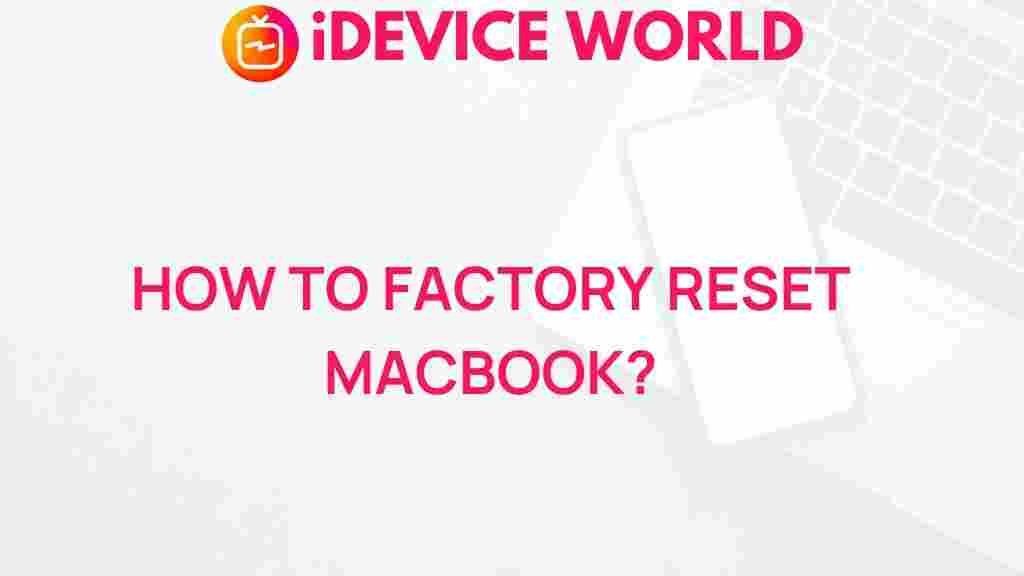Understanding the Benefits of a Factory Reset on Your MacBook
Performing a factory reset on your MacBook can be a powerful way to restore your device to peak performance. Whether you’re experiencing software issues, preparing to sell your laptop, or just looking for a fresh start, a factory reset can help you eliminate lingering issues and start anew. In this article, we’ll explore the various benefits of performing a factory reset on your MacBook, walk you through the entire process, and offer troubleshooting tips for a smooth experience.
Why Choose a Factory Reset?
Opting for a factory reset can be an effective solution to resolve various issues that accumulate over time on your MacBook. Here are some of the most compelling reasons to undertake a factory reset:
- Boost Performance: Resetting can help remove old files, fragmented memory, and redundant data that slow down performance.
- Fix Software Issues: A reset can solve persistent software issues or bugs, especially after system updates or software installations.
- Enhance Security: Factory resetting removes all personal data, offering you peace of mind if you’re selling or giving away your MacBook.
Knowing these advantages, let’s dive into how to safely perform a factory reset on your MacBook.
Preparing for a Factory Reset
Before beginning the factory reset process, take the following precautions:
1. Backup Your Data
A factory reset erases all data from your MacBook. To preserve your files, back up your data to an external drive or the cloud using Time Machine or another backup solution.
2. Sign Out of iCloud, iMessage, and Other Accounts
Ensure you sign out of iCloud, iMessage, and any other accounts connected to your MacBook to prevent issues with activation lock and data syncing on other devices.
3. Deauthorize Your MacBook from iTunes
Deauthorize your MacBook from iTunes to avoid problems accessing your music or other purchased content on a new device.
How to Perform a Factory Reset on Your MacBook
Once you’re prepared, follow these steps to carry out a factory reset on your MacBook.
Step 1: Restart Your Mac in Recovery Mode
To access the tools needed to reset your MacBook, restart your computer in Recovery Mode by following these instructions:
- Hold down the Command + R keys while your MacBook restarts.
- Keep holding the keys until the Apple logo or spinning globe appears on the screen.
This will open the macOS Utilities window, allowing you to continue with the reset process.
Step 2: Erase the Hard Drive
In the macOS Utilities window, select Disk Utility and follow these steps to erase the hard drive:
- Select your main drive, typically named “Macintosh HD.”
- Click Erase at the top of the window.
- Select a file format. The default format, APFS, is recommended for macOS.
- Click Erase and confirm your choice.
After erasing your hard drive, exit Disk Utility to return to the macOS Utilities window.
Step 3: Reinstall macOS
Now, reinstall macOS to complete the factory reset:
- In the macOS Utilities window, choose Reinstall macOS.
- Follow the on-screen instructions to complete the installation.
This process may take some time, depending on your internet speed and device specifications. Once macOS is reinstalled, your MacBook will boot up as if it were brand new.
Troubleshooting Common Factory Reset Issues
Although a factory reset is straightforward, some issues can arise during the process. Here are troubleshooting tips to help you overcome common challenges:
Problem: Can’t Access Recovery Mode
If your MacBook doesn’t enter Recovery Mode, try the following solutions:
- Ensure you’re pressing the Command + R keys simultaneously at startup.
- Try using Option + Command + R to access internet-based Recovery Mode, which works on all compatible MacBook models.
If these solutions don’t work, you may need to contact Apple Support for further assistance.
Problem: macOS Won’t Reinstall
Sometimes, the macOS installation process can stall. Here’s what to do:
- Check your internet connection, as macOS reinstallation requires a stable internet connection.
- Try restarting your MacBook and repeat the process to see if it resolves the issue.
If the problem persists, a local Apple Store can assist with reinstalling macOS.
Post-Reset Setup: Getting Your MacBook Ready
After completing a factory reset, set up your MacBook as follows:
1. Restore Files from Backup
If you backed up your data with Time Machine, use it to restore your files. For cloud or external storage backups, simply transfer your files back to your MacBook.
2. Reconfigure Settings
Reset your preferences, including settings for display, network, and software to match your needs.
3. Reinstall Essential Applications
Only reinstall the apps you use frequently, ensuring you start with a clean and clutter-free MacBook.
Final Thoughts on the Power of a Factory Reset
By following this comprehensive guide, you can perform a factory reset to unlock your MacBook’s full potential. A factory reset helps to eliminate software issues, optimize performance, and prepare your MacBook for a fresh start or a new user. Remember to always back up your data and sign out of accounts before beginning the reset process. A properly executed factory reset can transform your MacBook, making it as responsive and efficient as when you first bought it.
For more tech tips and troubleshooting guides, check out our MacBook support articles to keep your device running smoothly.
This article is in the category Guides & Tutorials and created by iDeciveWorld Team
